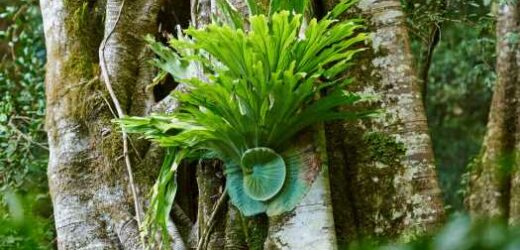K.C. Burns’s favorite research days are the ones where he puts on his backpack and walks into the wilderness with no agenda. On one hike on Australia’s Lord Howe Island, he came across a cluster of staghorn ferns. They are common potted plants, but in nature they grow in dense colonies that cling to treetops. In the volcanic island’s stunted forest, those treetops are right at eye level.
“I almost looked beyond it,” said Dr. Burns, a biologist at Victoria University of Wellington in New Zealand. Then he peered closer and realized the plants within the colony were doing different jobs to survive. Ferns growing higher up had waxy fronds that seemed to direct rainwater into the colony’s center. Farther down, ferns grew spongier leaves that were damp to the touch. Some plants weren’t reproducing at all — they seemed to have dedicated their lives to collecting water for their neighbors’ entangled roots.
It struck Dr. Burns that the ferns were working together as a kind of superorganism, perhaps like bees in a hive.
“I sat down and thought, oh my God,” he said. In a paper published last month in Ecology, Dr. Burns and his co-authors argued that colonies of the staghorn fern Platycerium bifurcatum show a kind of collective behavior known as eusociality. Until now, scientists had only recognized eusociality in some species of animals like bees or ants that live in colonies and divide their labor.
To measure how ferns divided labor, the researchers sampled plants growing at different heights within 24 colonies. They counted two types of leaves on each plant. One type, which they called nest fronds, are rounded and mostly brown, clasping the tree like cupped hands. The other fronds, long, green and forked like antlers, can grow spores on their undersides that will become the next generation of ferns.
Plants closer to the top of each colony had more spore-bearing fronds. Plants near the bottom had more of the cupped, non-reproducing nest fronds. About 40 percent of individual plants weren’t reproducing at all, like worker bees.
Next the scientists cut out wedges from nest fronds, dried them, then soaked them in water to measure how much they sopped up. They found that nest fronds from the bottom of a colony were more absorbent.
Since the colony’s roots grew in a tangled network, these spongy leaves might help the whole colony stay hydrated. The scientists found that larger colonies (the biggest one they studied held 58 individual ferns) had more spore-bearing fronds per capita. Living in a big group, then, might improve the ferns’ fitness.
For the most part, the groups are families. “We quickly realized the genetics is important,” Dr. Burns said, because eusocial animals live in closely related groups.
When researchers analyzed DNA from 11 fern colonies, they found that most plants within a colony were as closely related as possible: They were clones. New plants arise from buds in the root systems of others, Dr. Burns said.
Being clones “means that the different individuals have aligned interests genetically,” said Guy Cooper, an evolutionary biologist at the University of Oxford. By helping a neighboring clone, a plant is also helping its own genes survive.
Dr. Cooper said he would like to know more about the life cycle of a colony, and how much the individual ferns depended on one another.
Even if staghorn ferns aren’t as social as bees, “it was very cool to see that there might be similar sorts of complex social behaviors happening in plants,” he said.
He also pointed out that some plants that spread by cloning themselves were considered to be one individual, not many. For example, aspen trees sprout massive groves of clones from one root network. An aspen forest in Utah nicknamed Pando is sometimes called the world’s largest single organism, covering 106 acres.
“You then have to wonder about some more philosophical questions about whether they are different individuals to start with,” Dr. Cooper said of the ferns. Maybe the ferns within a colony are more like limbs on a body than bees in a hive.
Cloning doesn’t explain the whole story of staghorn ferns, though. In some Lord Howe Island colonies, Dr. Burns and his colleagues found unrelated plants. They don’t know how those ferns became part of the treetop communities.
Plants are some of the most flexible living things on Earth, said Karen Kapheim, a biologist at Utah State University who studies the evolution of social behavior in bees. Maybe it’s not surprising that a fern could also evolve social tendencies, she said.
Science is revealing more and more about how plants behave and communicate, Dr. Kapheim said. “I think adding social behavior to that fits in with this new, emerging understanding of plants.”
Source: Read Full Article



